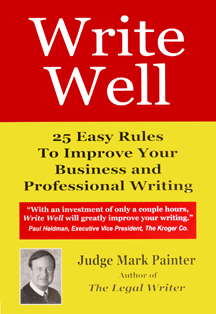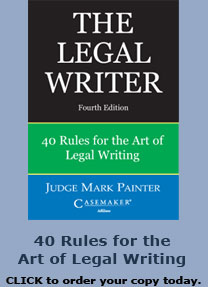The fight against bad writing continues
By Judge Mark P. Painter
This is my 60th column on legal writing. The articles have covered a lot of ground. But the fight goes on.
After attending my seminar in New Orleans, Louisiana workers’ compensation judge Elizabeth Warren sent me a filing, from which I extracted this gem of a paragraph. I’ve disguised it to protect the guilty. It’s a response to a motion, so I’ll just call it a filing.
One sentence
“Should the Court determine that a hearing is necessary, the Government requests leave to supplement its’ filing with a factual chronology of the defendant’s own admissions of guilt in debriefings with the Federal Bureau of Investigation, the defendant’s uncorroborated allegations of wrongdoing by others, the defendant’s attempts to dissuade the government from prosecuting him through a series of threats relayed by him and others on his behalf about the damaging fallout that a prosecution against him would incur and the steps taken by the U.S. Attorney’s Office to insure that if and when such a motion was filed as the one pending, we would be able to pinpoint with certainty the steps taken to insure an independent analysis of any legal relevance [Defendant’s] allegations had to this or any other prosecution undertaken by this office.”
Where to start?
The problems with this example are numerous:
• Never use Courier type. It is difficult to read and connotes a 1940 Underwood. One of many reasons is that Courier is a monospaced type, which makes justification problematic. Using Courier marks you as a rube.
• The sentence is 135 words long. The limit is 40, and average should be 18.
• The passage tests at the 57th grade, meaning that to understand it the first time, you must have completed 57 years of formal schooling. Do you know anyone who has been to the 57th grade?
• The readability score – on a 100-point scale – is 0.
• There is no such word as its’. The desired word is its. And it’s no typo – it’s used again later.
• The proper word is ensured, not insured.
Almost every conceivable error
Things get worse. The next page has this in the middle of a paragraph:
See United States v. Bolden, 353 F.3d 870, 875-876 (10th Cir. 2003); see also In Re Harris County, Texas, 240 Fed. Appx. 644,645-646 (5th Cir. 2007).
This has even more problems:
• Instead of italics, the filing uses underlining. Underling is a signal to the typesetter (formerly an actual person) to use italics. We had to use underlining with typewriters, but now our word processors do italics quite nicely.
• The jumble of letters and numbers is in the body, making the paragraphs difficult to read.
• The punctuation of the cites is also messed up, but we won’t quibble about that.
This sentence shows another flaw:
The [Plaintiff] opposes this motion because the relief requested —disqualifying an entire government office—is not available.
The author evidently thinks that em dashes (—) and hyphens (-) are interchangeable. We can now easily do proper em dashes—we had to use two hyphens on typewriters. I assume this person was using a word processor. But even on a typewriter, just one hyphen for a dash was never acceptable.
Never use talking footnotes, as they are impossible to read. You should also avoid block quotes, because the reader will simply skip them.
Another bewildering paragraph
“Nonetheless, now obligated to respond to [Defendant’s] shell of a vehicle giving expression to his unsupported vitriol against his accusers and victims, the [Plaintiff] also is compelled to indicate tersely that [Defendant’s] related allegation of suppressed evidence is untrue. Fortunately, [Defendant’s] mendacity with the facts is as disprovable as his mendacity with the law. And the mendacity was predictable. As soon as [Defendant] littered his own admissions of considerable fraudulent criminal activities in his practice as a lawyer with false and unsupported impugns of others – and sought specifically to connect his aspersions to other persons [Defendant] might think would invite the government to consider leniency for him, above all, to other pending and past public figure prosecutions – this Office, unknown to [Defendant], took precisely the safeguarding action [Defendant] wrongly guesses and contends with sinister implication did not occur.”
Here are the problems:
• This paragraph, with an average of 34 words per sentence, checks out at the 21st grade.
• The writer does start a sentence with an and, so he gets credit for that. But it’s not enough to save the paragraph, which has a readability of 9 on a 100-point scale.
• I’ve never seen “impugns” used as a noun. And neither has the dictionary.
• Tersely seems misused.
• It too uses a hyphen for an em dash.
• The last sentence is 79 words and unfathomable.
As I’ve said before, when writing about bad legal writing, you are never at a loss for a bad example – advance sheets come every week. But this document had so many typical errors that it was a particularly fitting example.
Readability
I always show the readability levels for the column. They are (my writing only) 11 words per sentence, 5% passive voice, and grade level 6.7.
____________________________________
Mark Painter has served as a judge on the Ohio First District Court of Appeals for 13 years, after 13 years on the Hamilton County Municipal Court. Judge Painter is the author of 365 nationally published decisions, 120 legal articles, and six books, including The Legal Writer: 40 Rules for the Art of Legal Writing, which is available at http://store.cincybooks.com. Judge Painter has given dozens of seminars on legal writing. Contact him through his website, www.judgepainter.org.








